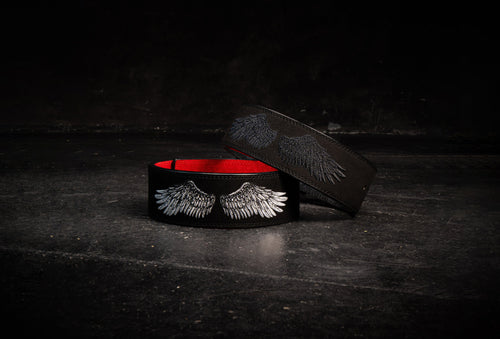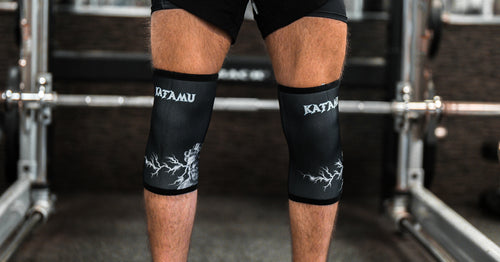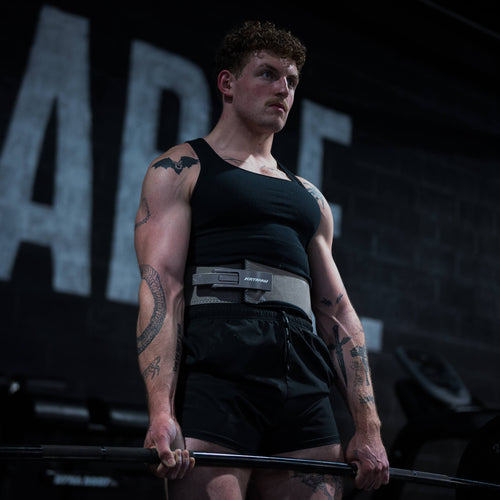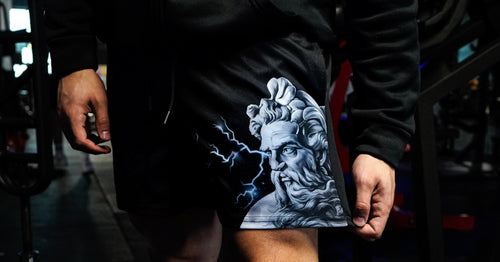Unlock your true squat potential in 2025 by mastering the squat belt and perfecting your form. If you want to lift heavier, safer, and with more confidence, understanding how to use a squat belt is essential.
This guide shows you how to maximize support, safety, and performance with your squat belt. You'll discover not just how these belts work, but also who should use them, how to pick the right one, and expert tips for flawless technique.
Ready to lift better and prevent injury? Dive in to learn about common mistakes, advanced form, and the latest squat belt innovations for 2025. Your strongest squats start here.
Understanding Squat Belts: What They Are and How They Work
Unlocking the power of a squat belt is about more than just strapping on a piece of gear. To truly benefit, you need to understand what a squat belt is, how it’s designed, and why it matters for your lifts. In this section, we’ll break down the anatomy, explore the science behind its effectiveness, and help you decide when a squat belt is right for your training.
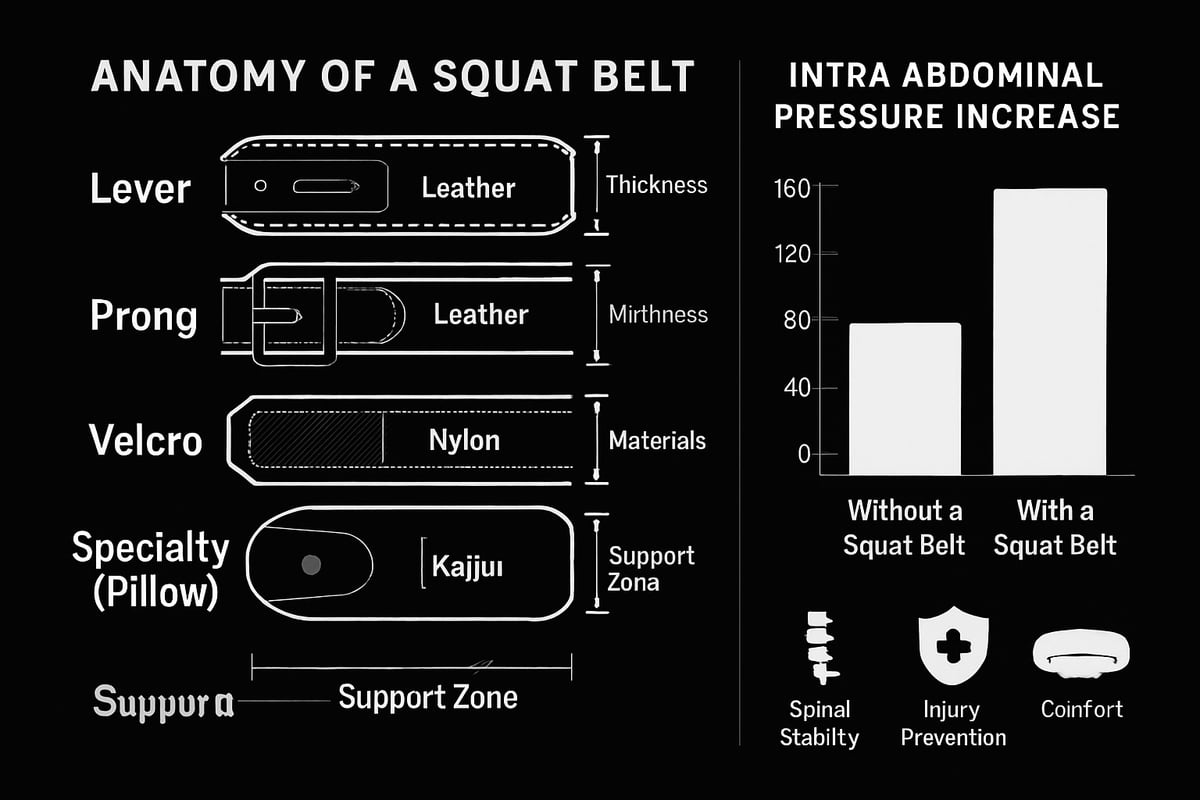
The Anatomy of a Squat Belt
A squat belt is engineered to provide targeted support during heavy lifts. At its core, the design focuses on width, thickness, and material. Most squat belts are between 10 and 13 millimeters thick, with widths ranging from 4 to 6 inches. Materials like genuine leather offer rigidity, while nylon brings flexibility and comfort.
There are several types of squat belt options to consider:
- Lever belts: Quick to secure and highly rigid
- Prong belts: Offer adjustable tightness and security
- Velcro belts: Lightweight and easy to adjust for dynamic training
- Specialty belts: Pillow belts feature multi-loop systems and innovative materials for maximum comfort
Squat belts differ from other lifting belts. For example, deadlift and Olympic belts often have tapered designs or different widths. A squat belt emphasizes even support across the torso, which is crucial for bracing.
Key features to look for include adjustability, padding, and clear support zones. The Pillow Belt is a standout, using a multi-loop system and Kaiju material for enhanced comfort and long-term durability. With the right squat belt, you’ll notice a difference in both confidence and performance.
Biomechanics and Benefits
The main advantage of a squat belt is its impact on your biomechanics. When you wear a squat belt correctly, it increases intra-abdominal pressure (IAP), which stabilizes your spine during heavy squats. Research shows that a squat belt can raise IAP by 20 to 40 percent, making your core more rigid and protecting your back.
This extra pressure helps reduce spinal flexion and the risk of injury. With a squat belt, you can maintain a stronger, more upright posture. The benefits extend to performance too. Increased trunk stiffness means you can push for more reps and higher weights with better control.
Athletes often share stories of reduced hip pain and improved comfort when using a squat belt. Some report being able to train longer and recover faster. For a deeper dive into how squat belts affect your body, check out this Effectiveness of weight-belts during squat exercise study, which explores the science behind their supportive power. Whether you lift recreationally or competitively, the right squat belt can be a game-changer for both safety and strength.
When and Why to Use a Squat Belt
Knowing when to use a squat belt is just as important as choosing the right one. The squat belt shines during heavy lifts, personal records, or when you need extra support to avoid injury. It’s especially valuable for powerlifters, strength athletes, and anyone recovering from back issues.
However, using a squat belt every day has its pros and cons. Some argue that frequent use can limit core development, while others value the added safety and confidence. It’s smart to use a squat belt for your heaviest sets, but keep lighter sets belt-free to strengthen your core.
Different athletes have different approaches. Some never touch a squat belt, while others rely on it for every session. The key is to listen to your body, evaluate your goals, and use the squat belt as a tool—not a crutch. With thoughtful use, you’ll lift safer, stronger, and with more control.
Choosing the Right Squat Belt for Your Needs
Selecting the ideal squat belt can be a game-changer for both beginners and seasoned lifters. With so many options available, it is important to find a squat belt that matches your goals, body type, and training style. Let us break down the process into manageable steps so you can lift with confidence and comfort.
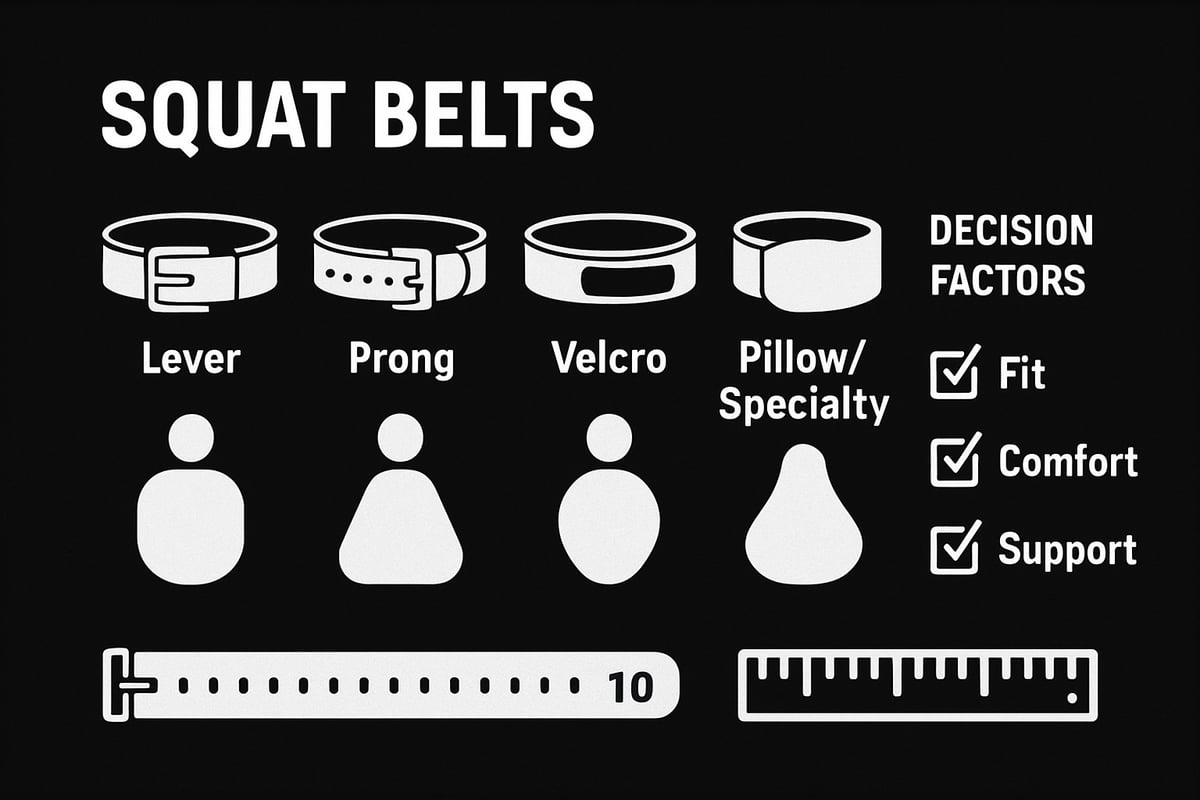
Factors to Consider
When choosing a squat belt, start by assessing your individual needs. Your body type plays a major role. Look for sizing guides and adjustable loops to ensure a snug fit. Some brands even offer gender-specific squat belt options for better comfort.
Next, consider your weight class and preferred lift type. Heavier lifters often benefit from thicker, wider belts, while lighter athletes may prefer a slimmer squat belt for mobility. Material matters as well. Leather belts offer rigidity and support, while nylon or pillow-style options provide softness and flexibility.
Comfort and support should balance out. For example, the Pillow Belt’s soft, contouring design maximizes comfort without sacrificing support. Durability is another key factor. Look for high-quality materials and generous warranties that protect your investment. Finally, set your budget. Prices range from entry-level to premium, and some brands offer bundled kits for extra value.
Popular Squat Belt Types and Use Cases
Understanding the different squat belt styles will help you pick one that suits your training. Here is a quick comparison:
| Belt Type | Pros | Cons | Best For |
|---|---|---|---|
| Lever | Easy on/off, super secure | Less adjustable | Powerlifters, max lifts |
| Prong | Highly adjustable | Slower to fasten | Versatile, all users |
| Velcro | Flexible, lightweight | Less rigid | Dynamic training |
| Pillow/Specialty | Maximum comfort, inclusive | Bulky for some | Rehab, everyday use |
Lever belts are favored for their quick locking mechanism and stability, making them a top pick for powerlifters. Prong belts stand out for adjustability and security, perfect for those who want flexibility in fit. Velcro belts are lightweight and ideal for circuit training or dynamic movements. Specialty belts, like hip or pillow options, shine when comfort and inclusivity are priorities. The Spud Inc. Pillow Belt, for example, offers multi-size adjustment and plush softness, making it accessible for a wide range of users.
Sizing and Fit: Getting It Right
Getting the right size squat belt is crucial for safety and performance. Measure your waist at the point where you plan to wear the belt, not your pant size. Sizing recommendations typically go as follows: Small for under 120 lbs, Large for 120–275 lbs, and XL for 275–400 lbs.
A proper fit means the squat belt feels snug but does not restrict your breathing. Avoid wearing it too high or too low, and make sure it is not overly tight or loose. Common mistakes include picking the wrong size or ignoring comfort features, which can lead to pain and poor results.
For step-by-step instructions and additional tips, check out this Weightlifting belt sizing guide. User reviews often highlight how the right fit improves comfort and performance, so take the time to get it right.
Step-by-Step: How to Use a Squat Belt for Maximum Support
Unlocking the full benefits of a squat belt starts with understanding precise setup and technique. Proper use means more than just strapping it on. Each step, from placement to breathing, helps you lift heavier and safer while protecting your spine.
Whether you are new to lifting or a seasoned athlete, following these steps will help you get the most out of your squat belt, maximize support, and avoid common mistakes.
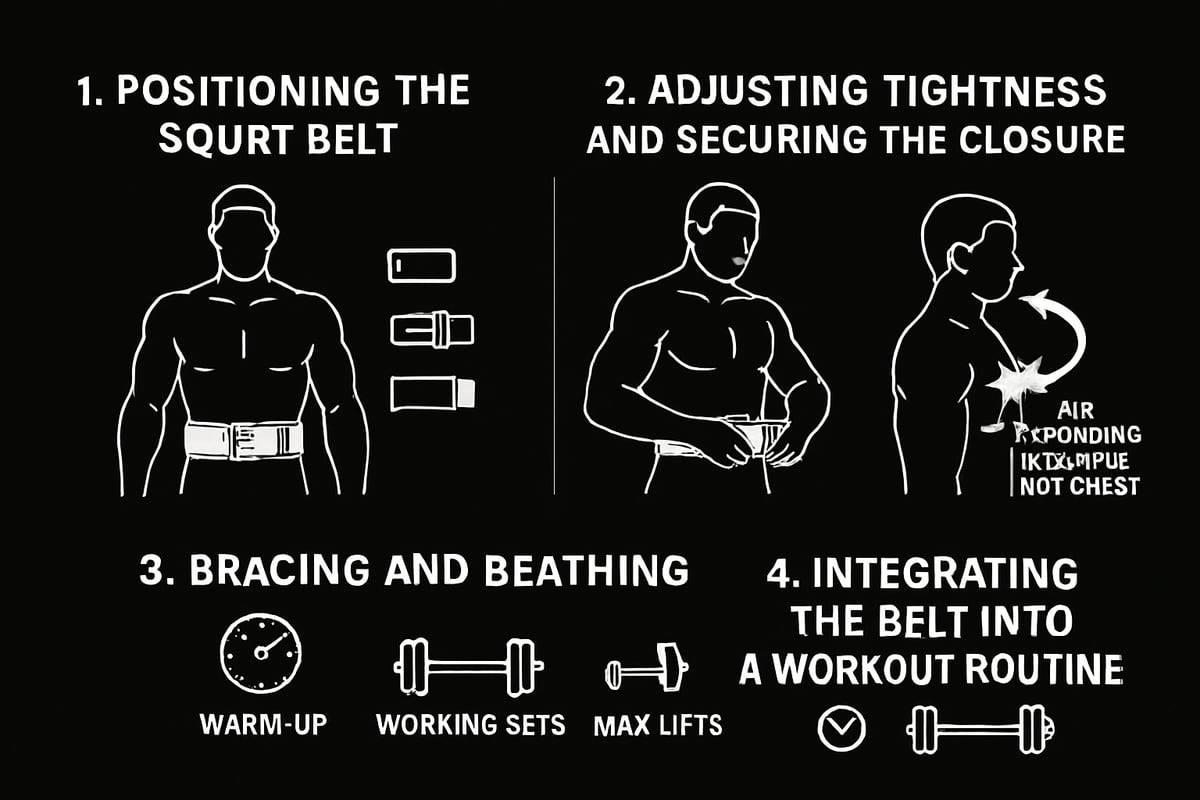
1. Positioning the Belt Correctly
The first step in using a squat belt is finding the right position on your torso. For most lifters, the belt sits above the hips and below the ribs, wrapping around the natural waist. This placement allows the belt to provide maximum support without limiting movement.
However, everyone’s anatomy is different. Some athletes prefer the belt slightly higher or lower depending on squat style. High bar squats often feel best with the belt a bit higher, while low bar squats may require a lower position.
If you have prominent hip bones, a wider, cushioned squat belt can help reduce discomfort and prevent the belt from digging in. Specialty belts like pillow belts are designed for extra comfort in these situations.
Tips for correct positioning:
- Place the squat belt snugly around your waist, not your stomach or hips.
- Test different heights during warm-ups to find your sweet spot.
- Make sure the belt does not pinch or restrict your natural squat depth.
Finding your ideal squat belt placement may take a few sessions, so be patient and adjust until it feels both supportive and comfortable.
2. Securing the Belt: Tightness and Comfort
Getting the tightness right is crucial for both support and comfort. A squat belt should feel snug enough to brace against but not so tight that it restricts breathing or pinches your skin.
There are several closure types to consider:
- Lever: Quick to fasten, ideal for those who want a consistent fit.
- Prong: Offers more micro-adjustment, great for fine-tuning tightness.
- Velcro: Easy to take on and off, good for dynamic workouts or quick adjustments.
How tight should your squat belt be? You should be able to slide a finger between the belt and your body, but not much more. If you struggle to breathe deeply, it is too tight. If you feel the belt shifting during your squat, it may be too loose.
Be mindful not to overtighten, which can lead to discomfort or even restrict core activation. The "corset" mistake, where lifters cinch the belt excessively, is a common error. Adjust the squat belt as needed between sets, especially if your torso or breathing changes during your workout.
Remember that individual comfort matters. Some people prefer a bit more slack, while others like a firmer feel.
3. Bracing and Breathing Techniques
Once your squat belt is positioned and secured, mastering bracing and breathing is the next step. The "breathe into the belt" method is essential. Instead of lifting your chest, focus on expanding your stomach and pushing it into the belt.
Follow this step-by-step process:
- Take a deep breath through your nose, filling your belly with air.
- Brace your core by pushing out against the squat belt in all directions.
- Hold this tension as you descend into the squat.
- Exhale at the top after you have completed the lift.
Proper bracing increases intra-abdominal pressure, which stabilizes your spine and allows you to lift heavier weights safely. Research shows that using a squat belt with correct bracing can enhance trunk stiffness and power output while reducing injury risk.
Practicing this technique without weight first can help you develop the habit. Many lifters find cues like "fill the belt with air" or "expand your core 360 degrees" useful for learning the correct approach.
For more on safe lifting and proper support, check out Our mission for lifting safety.
4. Integrating the Belt into Your Routine
Knowing when and how to use your squat belt during training is just as important as technique. It is best to reserve the belt for heavier sets, max attempts, or when you need extra support.
Start your workout with belt-free warm-ups and lighter sets to build raw core strength. Add the squat belt as you approach working sets or high-intensity lifts. This helps you avoid overreliance and keeps your core muscles active.
Practical tips for integration:
- Keep your squat belt in your gym bag for easy access.
- Use the belt only when you truly need it, not for every set.
- Focus on quality reps and proper form with and without the belt.
Over time, you will develop a feel for when the squat belt adds value and when to train without it. This balanced approach supports both performance and long-term strength gains.
Advanced Squat Form and Belt Synergy in 2025
Unlocking the full power of your squat belt is about more than just strapping it on. When advanced squat form meets the latest squat belt technology, you can achieve new heights in safety, stability, and performance. Let’s break down how to create true synergy between your squat mechanics and your gear in 2025.
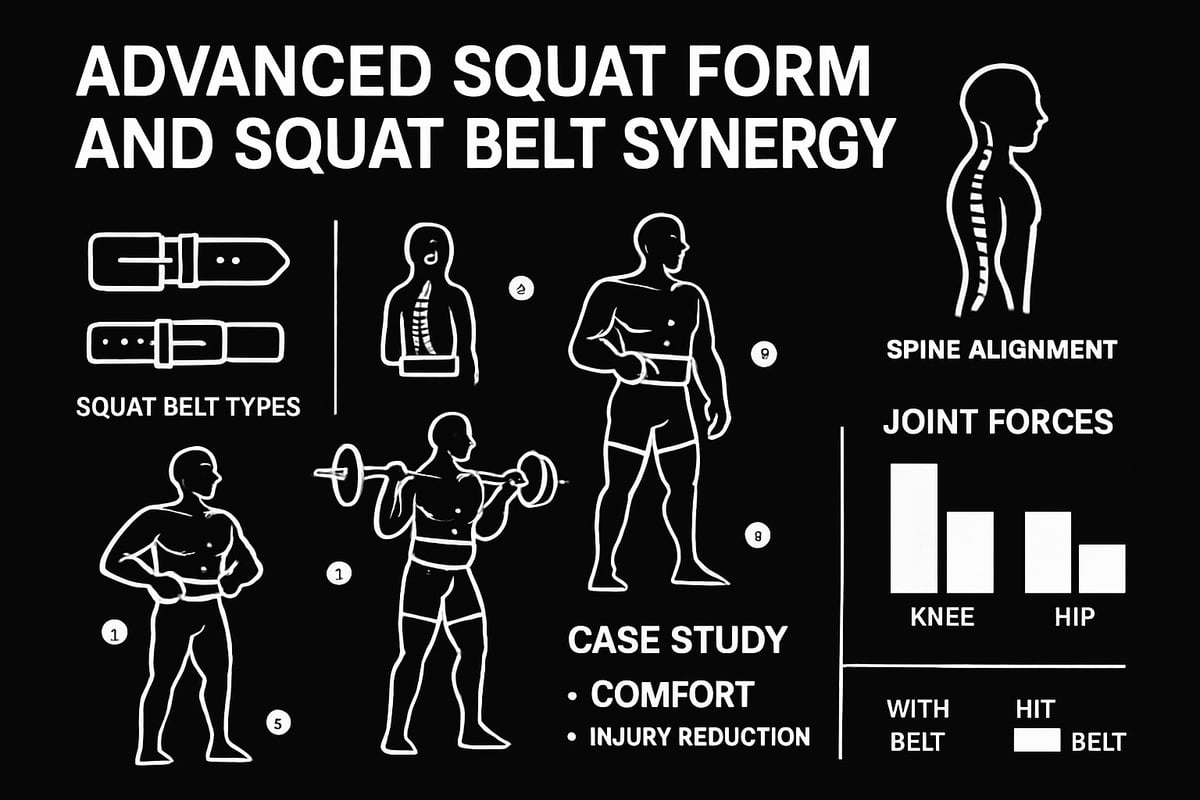
Optimizing Squat Mechanics with a Belt
A squat belt is a game-changer when it comes to maintaining proper squat mechanics. Wearing your squat belt correctly helps you keep an upright torso and a neutral spine, which is crucial for both power and injury prevention. The right squat belt also encourages your knees to track in line with your toes, providing a stable base for heavy lifts.
Different squat variations demand unique approaches to belt use. For example, a high bar squat often pairs best with a slightly higher belt placement, while a low bar squat may benefit from a lower, more snug fit. Specialty moves like front squats or belt squats require you to experiment with placement and belt style for optimal support.
Athletes with previous injuries, such as pelvic reconstruction, have found that integrating a squat belt with belt squats can dramatically reduce discomfort and risk. According to a biomechanical analysis of hip, knee, and ankle joint forces during squats, correct squat mechanics with supportive gear can lower joint stress and improve overall performance.
| Squat Variation | Belt Placement | Key Focus |
|---|---|---|
| High Bar Squat | Above hips | Upright torso, depth |
| Low Bar Squat | Lower on waist | Hip drive, stability |
| Front Squat | Mid-abdomen | Core bracing, posture |
| Belt Squat | Hips | Comfort, injury relief |
A squat belt can be your secret weapon for tackling advanced squat forms, whether you’re recovering from injury or pushing for new PRs.
Troubleshooting Common Issues
Even the best squat belt can cause issues if not set up for your body. Common problems include hip or rib discomfort, the belt digging in, or bruising after heavy sessions. Choosing the right width and material makes all the difference. Wider, padded belts distribute pressure, reducing pain for those with bony hips.
Every lifter has unique anatomy. If you have a short torso or curvy hips, experiment with both placement and belt design. Specialty belts, like pillow-style or multi-loop options, offer customized comfort for a range of body types.
Here’s how to address common comfort issues:
- Try a softer or contoured squat belt for sensitive areas.
- Adjust belt height to avoid pinching ribs or hips.
- Opt for belts with extra padding if bruising is an issue.
- Listen to user feedback and read reviews to find the best match.
Modern squat belt designs focus on inclusivity and comfort, so don’t settle for “good enough.” Real athlete testimonials highlight significant improvements in comfort after switching to new materials or tailored fits.
Progressive Overload and Belt Use
Using a squat belt is not just about lifting heavier, but also about lifting smarter. To safely increase your weights, monitor your form closely. Let the squat belt support your trunk, but don’t let it replace good technique or raw core strength.
Athletes report being able to perform more reps and handle greater loads with proper squat belt use. However, watch for signs of belt dependency, such as collapsing form without it. Plan regular deload weeks or belt-free training cycles to keep your core muscles strong and responsive.
Tips for progressive overload with a squat belt:
- Increase weight gradually, focusing on form first.
- Use the squat belt only on working sets or max attempts, not warm-ups.
- Alternate between belted and belt-free squats to build balanced strength.
- Track performance and comfort to gauge progress.
A squat belt should empower you to take your training to the next level, not become a crutch. Use it as a tool for progression, not a shortcut.
Common Mistakes and How to Avoid Them
Squat belts are powerful tools, but even experienced lifters fall into common traps. Avoiding these mistakes can make the difference between progress and pain. Let’s break down the most frequent squat belt errors and how to sidestep them.
Misusing the Belt
Many lifters misuse their squat belt by wearing it too tight, too loose, or placing it incorrectly. Tightening the belt until you can barely breathe restricts movement and can actually reduce intra-abdominal pressure. On the other hand, a loose squat belt offers little to no support.
Common mistakes include:
- Wearing the belt too high on the ribs or too low on the hips
- Skipping proper bracing and breathing techniques
- Using the squat belt on lifts where it’s not needed
To maximize support, position the belt just above your hip bones and below your ribs. Always practice bracing by taking a deep breath into your belly before each rep.
Overreliance and Core Weakness
Using a squat belt on every set can lead to underdeveloped core muscles. If you rely on the belt for all lifts, your natural stability may decline.
To prevent this:
- Reserve the squat belt for heavy sets and max attempts
- Train core stability without the belt on lighter weights
- Focus on proper bracing even when not wearing the squat belt
Remember, the squat belt should enhance—not replace—your core strength.
Ignoring Fit and Comfort
Wearing the wrong size or type of squat belt can cause discomfort and limit performance. Belts that are too small might dig into your sides, while oversized belts shift during lifts.
Key points to consider:
- Measure your waist accurately for the right fit
- Choose a style that matches your body type and preferences
- Look for comfort features like padding and adjustability
Ignoring these factors can result in bruising, pinching, or even reduced squat depth.
Neglecting Maintenance and Replacement
A squat belt is only as good as its condition. Over time, materials can wear out, buckles may fail, and support can diminish.
To keep your squat belt in peak shape:
- Regularly inspect for worn spots, loose stitching, or faulty hardware
- Clean your belt according to manufacturer instructions
- Replace your squat belt when it no longer provides reliable support
Proper care extends the life of your belt and ensures consistent performance in the gym.
Example-Driven Solutions
Many lifters have transformed their training by correcting these mistakes. For example, one athlete struggled with hip bruising until switching to a wider, padded squat belt. Another found better stability by adjusting the belt’s position and practicing bracing drills.
If you’re still unsure about fit or usage, reach out for personalized squat belt advice to get expert recommendations tailored to your needs. Listening to both experts and the lifting community can help you turn discomfort into confidence.
Innovations and Trends in Squat Belts for 2025
Squat belt technology is evolving rapidly in 2025, bringing new levels of comfort, support, and customization to lifters of all backgrounds. Whether you are a powerlifter or just starting out, the latest innovations are designed to help you lift safer and stronger.
New Materials and Designs
The squat belt landscape is seeing a surge in ultra-soft, contouring materials like Kaiju fabric and pillow-style padding. These advancements offer a plush feel without sacrificing support, making longer sessions more comfortable.
Modern designs now include multi-loop systems for more precise fit, helping users dial in their preferred level of tightness. Lightweight yet durable constructions are also trending, allowing athletes to wear their squat belt for extended periods without discomfort.
For a deeper dive into how these innovations impact performance and comfort, check out this brief review on the effects of the squat exercise, which highlights the role of equipment like squat belts in enhancing muscle hypertrophy and safety.
Smart Lifting Technology
The rise of smart technology is bringing real-time feedback to the squat belt market. Some new models feature integrated sensors that monitor intra-abdominal pressure, track form, and count reps.
With data-driven feedback, lifters can fine-tune their technique and maximize the benefits of their squat belt. These innovations are making it easier to spot weak points, improve bracing, and reduce the risk of injury.
As this technology matures, expect even more personalized coaching and analytics built right into your squat belt.
Customization and Inclusivity
Manufacturers are now prioritizing inclusivity, offering squat belt options for every body type, gender, and age group. You can find belts specifically designed for women, youth, and larger athletes, all available in a variety of widths and padding levels.
Personalization is also on the rise. Custom colors, patterns, and branding options let you express your style while maintaining top-notch support. Adjustable sizing ensures that your squat belt fits perfectly, no matter your build.
These trends make it easier for everyone to find a squat belt that feels tailor-made for their needs.
Community and Expert Resources
Lifters in 2025 have more resources than ever to master proper squat belt use. Online tutorials, expert video guides, and supportive communities are readily available to help you troubleshoot issues and refine your form.
User reviews and feedback are actively shaping the next generation of squat belt designs. Manufacturers listen to real-world experiences, which means belts are becoming more comfortable and effective each year.
The growing demand for comfort-driven innovations, like the Pillow Belt, reflects a broader trend toward safety and accessibility in strength training.
Now that you know what makes a squat belt truly effective and how the right fit can make all the difference for your lifts in 2025, why not take the next step? From premium lever belts with standout designs to all the extras like knee sleeves and wrist wraps, Katamu has your back—literally. If you’re ready to lift smarter, feel safer, and enjoy gear that’ll last for years, you deserve a setup that’s built for you. Explore the options, find your perfect match, and build your setup today. Your strongest squats are just ahead!
